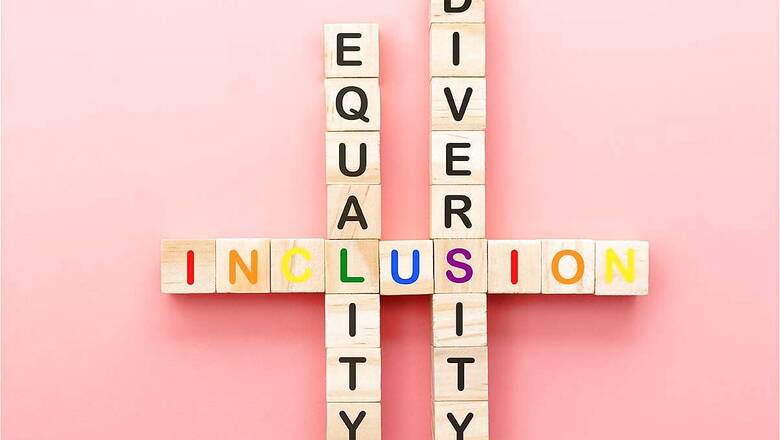
views
In India, where the nation has made tremendous strides in recent years to constructively address societal challenges, one section of the population continues to be inadvertently neglected by policy makers – the LGBTQ+ community. With an ever-increasing focus on development, many policies have taken a rather limited view, not adequately recognizing the diverse needs of all citizens.
For instance, India’s sanitation infrastructure has witnessed revolutionary changes with the Swachh Bharat Mission, with its stated aim to construct toilets for every single Indian person. Traditionally, however, Indian sanitation facilities have been built around a binary gender perspective, providing toilets for men and women. This leaves out non-binary individuals, transgender people, and other members of the LGBTQ+ community.
The toilet, a seemingly simple amenity, becomes a daily challenge for these individuals, who have to navigate the fear of humiliation, harassment, or even physical violence.
The Mental and Physical Toll
Imagine the daily stress and anxiety faced by a transgender person who has to constantly evaluate which public restroom to use, and then often faces ridicule or harassment, in addition to the ever present threat of physical confrontation. If that feels like hyperbole to you, come join us in a thought experiment.
Just for a moment, let’s assume you’re a cisgender man. You’re at an event, and you’ve really got to go to the toilet. You reach the toilets, but… there are no men’s toilets! Just toilets for women. What do you do? Let’s assume that you choose to quickly run in, do your business, and get out before anyone notices. While you’re in one of the stalls, a group of women walk in, and are now queueing up outside your stall. You delay as long as you can, and then, sheepishly, step out. The women all glare at you. Some even call you out on your behaviour. You apologise continuously as you wash your hands, hoping that everyone remains reasonable, and get out of there as quickly as you can… just as one of the women threatens to call security.
Now imagine that the same thing happens at work. At the local park. At the train station. At the movie theatre. At restaurants. You can’t go to the toilet anywhere.
Ask yourself this: how many events will you avoid going to? How often will you pull back from eating and drinking at outings? How much of your mental energy at work will be eaten up by getting the ‘timing’ of your bathroom break right? How much anxiety would it add to your day?
That’s what a normal day feels like for a transgender and/or non-binary person.
It adds up. A study conducted in the United States revealed that 59% of transgender or gender-diverse participants avoided using public toilets due to fear of confrontations. According to another study, among the transgender and/or nonbinary youth who experienced bathroom discrimination, 85% reported depressive mood and 60% seriously considered suicide. These experiences are echoed by transgender and non-binary people everywhere, including India.
And that’s not all. There are physical repercussions too. Many transgender and/or non-binary people prefer to ‘hold it’ than subject themselves to the indignity of going to a toilet where they aren’t welcome. As we know, this can lead to the development of urinary tract infections, kidney problems, and other related health issues. Moreover, many of them also resort to restricting their food and water intake. This can and, with our weather, often does lead to dehydration.
This in turn, leads to greater sick days – be it during education or during work life. As we know from Mark Balla’s story, girls often drop out from school once they begin menstruation when they don’t have access to a clean and safe toilet. The same reasoning extends to transgender and non-binary people who menstruate.
Creating Safe, Inclusive Spaces
Creating inclusive toilet facilities can dramatically improve the well-being of LGBTQ+ individuals. By merely knowing that they have access to a safe space, free from judgement, transgender and non-binary people can experience a reduction in daily stress and anxiety levels. This, in turn, can lead to an overall improvement in mental health. Additionally, having access to inclusive and safe toilets means that they don’t have to restrict their food and water intake, which encourages better hydration and nutrition, positively impacting their physical health.
While this isn’t a one-size-fits-all solution, gender neutral bathrooms are generally considered the most cost effective, safe and inclusive solution. These facilities are not designated as male or female and can be used by anyone regardless of gender. No one gets stopped from using these, because it doesn’t matter how you identify – these are spaces that welcome us all.
Contrary to the misconception that gender-neutral toilets lack privacy, they are in fact, designed for it through the use of individual stalls. For women, these spaces can also mean more availability of toilets – as any woman who has stood in line to go to an overcrowded bathroom in a stadium can attest, the ratio of toilets for men and women is greatly skewed. By embracing gender neutral bathrooms, we can all get to the toilet sooner. For parents too, accompanying their children to the toilet becomes much easier – ask any dad who has had to accompany his daughter, and they’ll tell you what an awkward experience it is when they enter toilets reserved for men or women.
Promoting inclusive toilet facilities is not just beneficial for the LGBTQ+ community; it has broader societal implications. It creates spaces that foster acceptance and respect, contributing to a more inclusive and harmonious society.
Harpic, a brand renowned for its commitment to cleanliness, has embraced this call for change. With open hearts and a deep understanding, Harpic has taken remarkable strides to ensure that its products cater to the rich tapestry of society, which includes the LGBTQ+ community. Recognizing that education is the key to transforming attitudes, Harpic has launched inspiring campaigns that illuminate the beautiful diversity of gender identities. Through these powerful initiatives, society is awakened, nurtured, and encouraged to create environments where acceptance thrives.
Mission Swachhta aur Paani, a remarkable collaboration between Harpic and News18, transcends the concept of cleanliness alone. It is a movement that recognizes the profound significance of toilets, viewing them not merely as functional spaces but as beacons of safety and acceptance for the marginalised. This exceptional mission is built upon the firm belief that clean and inclusive toilets are vital for fostering a society that embraces and empowers us all, unconditionally. With unwavering dedication, Harpic and News18 actively include and advocate for the LGBTQ+ community, propelling the message that every individual deserves access to safe and accepting spaces, where their dignity is upheld, and their presence is celebrated.
The time is right for us to look past our own experiences, and embrace a larger perspective that others no one. We are one human race, and what happens to one of us, happens to all of us. In our march towards creating a safer, more equitable, more just society, this is one small step that will have far reaching consequences.
To know more about how you can play a part in this national conversation, join us here.



















Comments
0 comment